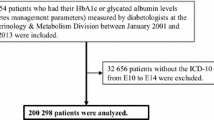Abstract
This study examined prescribing patterns for antidiabetic medications in France and explored the relationships between those patterns and changes in patient characteristics. Data were obtained from the IMS Disease Analyzer-Mediplus France Database (IMS Health Incorporated, London, United Kingdom). Patients were included in the study if they were identified as having type 2 diabetes during the calendar years 2001 to 2003. Univariate analyses examined changes in patient characteristics and trends in prescribing over time. In addition, multivariate logistic regression analysis examined the impact of the year on the likelihood of a patient’s receiving prescriptions for a specific therapy. A total of 14,281 unique diabetic patients were studied during the years 2001 through 2003. An average of 1.28 drug therapy episodes per calendar year was reported among individual users of antidiabetic agents. Univariate analysis revealed that between 2001 and 2003, monotherapy with sulfonylurea decreased from 34.98% to 29.47% (P < .0001), monotherapy with metformin increased from 17.38% to 21.31% (P < .0001), and monotherapy with insulin increased from 1.71% to 2.27% of the population (P=.0437). Multivariate logistic regression analyses that compared prescription therapy episodes in 2003 with those in 2001 revealed that the influence of the year on the likelihood of metformin or insulin use (alone or in combination with other medications) was positive and significant (P < .05). In contrast, the influence of the year on the likelihood of sulfonylurea monotherapy use was negative and significant (P < .05). In France, antidiabetic medication prescribing patterns changed from 2001 to 2003. In general, the trend has been away from sulfonylurea monotherapy and toward metformin monotherapy, insulin monotherapy, or combination therapy.
Similar content being viewed by others
References
Zimmet P, Alberti KG, Shaw J. Global and societal implications of the diabetes epidemic.Nature. 2001;414:782–787.
Ricordeau P, Weill A, Vallier N, et al. The prevalence and cost of diabetes in metropolitan France: what trends between 1998 and 2000?Diabetes Metab. 2003;29:497–504.
Williams R, Van Gaal L, Lucioni C, for the CODE-2 Advisory Board. Assessing the impact of complications on the costs of Type II diabetes.Diabetologia. 2002;45:S13-S17.
Liebl A, Mata M, Eschwege E. Evaluation of risk factors for development of complications in Type II diabetes in Europe.Diabetologia. 2002;45:S23-S28.
Liebl A, Neiss A, Spannheimer A, et al. Complications, co-morbidity, and blood glucose control in type 2 diabetes mellitus patients in Germany—Results from the CODE-2™ study.Exp Clin Endocrinol Diabetes. 2002;110:10–16.
Detournay B, Vauzelle-Kervroedan F, Charles MA, et al. Epidemiology, management, and costs of type 2 diabetes in France in 1998.Diabetes Metab. 1999;25:356–365.
Cramer P, Martinet J. Impact of biotechnology products on quality of life and longevity: insulin and insulin analogues, 2004. Available at: www.bioimpact.org. Accessed July 15, 2007.
Huber PJ. The behavior of maximum likelihood estimates under non-standard conditions. In:Proceedings of the Fifth Berkeley Symposium on Mathematical Statistics and Probability. Berkeley, Calif: University of California Press; 1967:221–223.
White H. A heteroskedasticity-consistent covariance matrix estimator and a direct test for heteroskedasticity.Econometrica. 1980;48:817–830.
White H. Maximum likelihood estimation of mis-specified models.Econometrica. 1982;50:1–25.
SAS User’s Guide, version 8. Cary, NC: SAS Institute; 1988.
Ricordeau P, Weill A, Vallier N, Bourrel R, Fender P, Allemand H. Epidemiology of diabetes in metropolitan France.Diabetes Metab. 2000;26(suppl 6):11–24.
Ritz E, Rychlik I, Locatelli F, Halimi S. End-stage renal failure in type 2 diabetes: a medical catastrophe of worldwide dimensions.Am J Kidney Dis. 1999;34:795–808.
Gadsby R. Epidemiology of diabetes.Adv Drug Delivery Rev. 2002;54:1165–1172.
Detournay B, Cros S, Charbonnel B, et al. Managing type 2 diabetes in France: the ECODIA survey.Diabetes Metab. 2000;26:363–369.
Massi-Benedetti M, for the CODE-2 Advisory Board. The cost of diabetes Type II in Europe: the CODE-2 study.Diabetologia. 2002;45:S1-S4.
Monnier L, Grimaldi A, Charbonnel B, et al. Management of French patients with type 2 diabetes mellitus in medical general practice: report of the Mediab observatory.Diabetes Metab. 2004;30:35–42.
Cohen FJ, Neslusan CA, Conklin JE, Song X. Recent antihyperglycemic prescribing trends for U.S. privately insured patients with type 2 diabetes.Diabetes Care. 2003;26:1847–1851.
Agence Nationale d’Accréditation et d’Évaluation en Santé (ANAES). Strategy for management of type 2 diabetics, excluding management of complications, 2000. Available at www.anaes.fr. Accessed July 15, 2007.
Glueck CJ, Fontaine RN, Wang P, et al. Metformin reduces weight, centripetal obesity, insulin, leptin, and low-density lipoprotein cholesterol in nondiabetic, morbidly obese subjects with body mass index greater than 30.Metabolism. 2001;50:856–861.
UK Prospective Diabetes Study (UKPDS) Group. Intensive blood glucose control with sulphonylureas or insulin compared with conventional treatment and the risk of complications in patients with type 2 diabetes (UKPDS 33).Lancet. 1998;352:837–853.
European Diabetes Policy Group. A desktop guide to type 2 diabetes mellitus.Diabet Med. 1999; 16:716–730.
John L, Rao PS, Kanagasabapathy AS. Prevalence of diabetic neuropathy in non-insulin dependent diabetes: prevalence of diabetic nephropathy in non-insulin dependent diabetes.Indian J Med Res. 1991;94:24–29.
Tovi J, Svanborg E, Nilsson BY, Engfeldt P. Diabetic neuropathy in elderly Type 2 diabetic patients: effects of insulin treatment.Acta Neurol Scand. 1998;98:346–353.
Author information
Authors and Affiliations
Corresponding author
Rights and permissions
About this article
Cite this article
Boyc, K.S., Yurgin, N. & Lage, M.J. Trends in the prescription of antidiabetic medications in France: Evidence from primary care physicians. Adv Therapy 24, 803–813 (2007). https://doi.org/10.1007/BF02849973
Issue Date:
DOI: https://doi.org/10.1007/BF02849973




